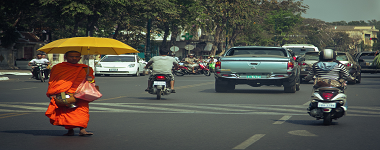by John West, Asian Century Institute
Cambodia has been called an “Olympian of Growth” by the World Bank. But there are deep problems in the Cambodian model of development, writes John West.

Cambodia, the “Growth Olympian”
Cambodia has been one of the “Olympians of Growth“, according to the World Bank. Its economy has grown at a yearly rate of 7.7% over the past two decades, making it the world’s sixth fastest growing economy (the eight “Olympians” include three other Asian countries, namely China, Laos and Vietnam).
Openness to trade and foreign investment has been a key driver of Cambodia’s economic growth, especially in the garment, tourism, construction, and agriculture sectors. The stock of inward FDI in Cambodia rose from $125 million in 1993 to $9.4 billion in 2013, an increase from 5% to 57% of GDP. And FDI has been the key driver of Cambodia’s exports.
Exports have contributed more than 50% to Cambodia’s over the past decade, with the US and Europe being the major export destinations. The garment sector, which accounts for three-quarters of merchandise exports, has benefited from preferential access to US and EU markets, and relocation of production from China as the latter’s wage costs have risen.
When a country is at the rock-bottom of the global development ladder, as Cambodia was, getting just a few things right (like its liberal trade and investment regime) can stimulate rapid growth. This is nevertheless an astonishing achievement for a country that was torn apart by a horrifically genocidal war just a few decades ago that killed one-quarter of its population.
Thanks to the strong economy, the share of Cambodia’s population living in extreme poverty has fallen sharply, from 53% in 2004 to 18% in 2012. Cambodia’s women, who account for 85% of the 600,000 employees in the garment sector, have benefited from the sector’s relatively higher wages.
Cambodia’s development challenges
Despite its “Olympian growth rates”, Cambodia remains a poor country reflecting the immense damage of the Khmer Rouge period. Its GDP per capita was a mere $1006 in 2013 (around $3000 in purchasing power parity terms), well below its neighbors of Laos and Vietnam, and the lowest in Southeast Asia. Cambodia still relies heavily on foreign assistance — 30-40% of the national government’s budget depends on donor aid.
Close to half the population still lives in “near poverty”, meaning that they are at great risk of falling back into poverty in the event of a natural calamity or economic shock. Malnutrition and stunting are prevalent. According to a measure of “multidimensional poverty”, which takes into account deprivations in addition to low income, Cambodia’s rate of poverty would have only fallen from 59% in 2005 to 46% in 2010, due to poor access to basic services like drinking water, sanitation, electricity and cooking fuel. Although the country is slowly urbanizing, close to 80% of the population still lives in rural areas.












Leave A Comment